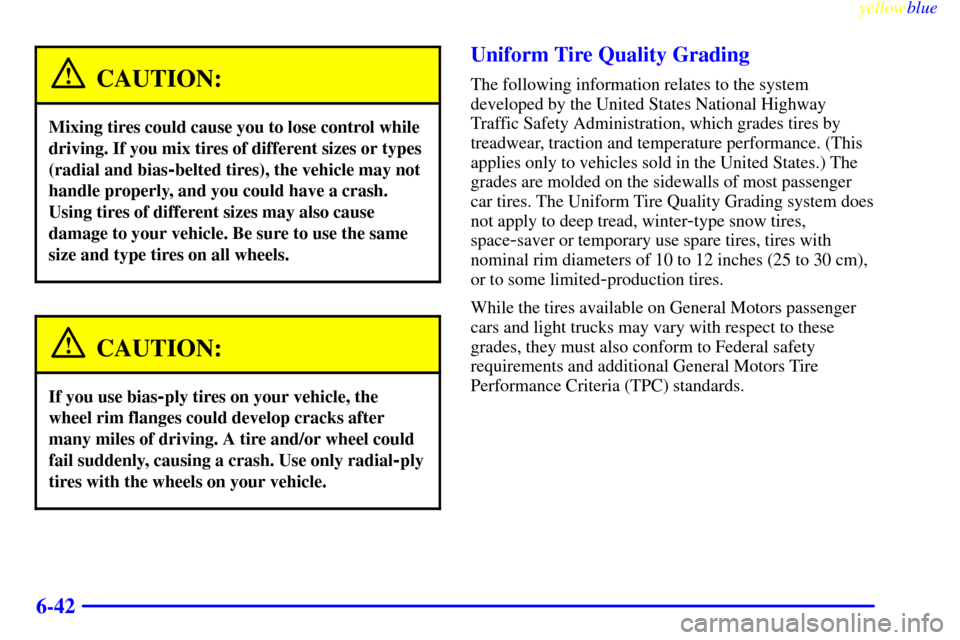Page 229 of 328
yellowblue
5-21
The tools you'll be using include the jack (A), the wheel
wrench (B) and the screwdriver (C).
Removing the Flat Tire and Installing the
Spare Tire
1. Use the flat end of the screwdriver to pry off the five
black plastic wheel bolt caps. Be careful not to
scratch the wheel edge.
Page 232 of 328
yellowblue
5-24
CAUTION:
Getting under a vehicle when it is jacked up is
dangerous. If the vehicle slips off the jack, you
could be badly injured or killed. Never get under
a vehicle when it is supported only by a jack.
CAUTION:
Raising your vehicle with the jack improperly
positioned can damage the vehicle and even make
the vehicle fall. To help avoid personal injury and
vehicle damage, be sure to fit the jack lift head
into the proper location before raising
the vehicle.6. Raise the vehicle by turning the jack handle
clockwise. Raise the vehicle far enough off the
ground for the spare tire to fit under the vehicle.
7. Remove all wheel bolts and take off the flat tire.
Page 233 of 328
yellowblue
5-25
8. Remove any rust or dirt
from the wheel bolts,
mounting surfaces and
spare wheel.
CAUTION:
Rust or dirt on the wheel, or on the parts to
which it is fastened, can make the wheel bolts
become loose after a time. The wheel could come
off and cause an accident. When you change a
wheel, remove any rust or dirt from the places
where the wheel attaches to the vehicle. In an
emergency, you can use a cloth or a paper towel
to do this; but be sure to use a scraper or wire
brush later, if you need to, to get all the rust or
dirt off.
CAUTION:
Never use oil or grease on wheel bolts. If you do,
the bolts might come loose. Your wheel could fall
off, causing a serious accident.
9. Place the wheel on the wheel-mounting surface.
10. Replace the wheel
bolts. Tighten each bolt
by hand until the wheel
is held against the hub.
Page 235 of 328
yellowblue
5-27
NOTICE:
Improperly tightened wheel bolts can lead to
brake pulsation and rotor damage. To avoid
expensive brake repairs, evenly tighten the wheel
bolts in the proper sequence and to the proper
torque specification.
Storing a Flat or Spare Tire and Tools
CAUTION:
Storing a jack, a tire or other equipment in the
passenger compartment of the vehicle could
cause injury. In a sudden stop or collision, loose
equipment could strike someone. Store all these
in the proper place.
After you've put the spare tire on your vehicle, you'll
need to store the flat tire in the trunk. Use the following
procedure to secure the flat tire in the trunk.
Put the flat tire in the trunk
where the spare is stored
(driver's side wheel well).
Secure the flat tire with the
straps that are used to hold
the spare in place.
Page 277 of 328

yellowblue
6-39
NOTICE: (Continued)
�Tire overloading
�Bad wear
�Bad handling
�Bad fuel economy.
If your tires have too much air (overinflation),
you can get the following:
�Unusual wear
�Bad handling
�Rough ride
�Needless damage from road hazards.
When to Check
Check your tires once a month or more. Also, check the
tire pressure of the spare tire.How to Check
Use a good quality pocket
-type gage to check tire
pressure. You can't tell if your tires are properly inflated
simply by looking at them. Radial tires may look
properly inflated even when they're underinflated.
Be sure to put the valve caps back on the valve stems.
They help prevent leaks by keeping out dirt
and moisture.
Tire Inspection and Rotation
Tires should be rotated at 5,000 miles (8 000 km) and
then every 10,000 miles (16 000 km) thereafter. Any
time you notice unusual wear, rotate your tires as soon
as possible and check wheel alignment. Also check for
damaged tires or wheels. See ªWhen It's Time for New
Tiresº and ªWheel Replacementº later in this section for
more information.
The purpose of regular rotation is to achieve more
uniform wear for all tires on the vehicle. The first
rotation is the most important. See ªScheduled
Maintenance Servicesº in the Maintenance Schedule
booklet for scheduled rotation intervals.
Page 280 of 328

yellowblue
6-42
CAUTION:
Mixing tires could cause you to lose control while
driving. If you mix tires of different sizes or types
(radial and bias
-belted tires), the vehicle may not
handle properly, and you could have a crash.
Using tires of different sizes may also cause
damage to your vehicle. Be sure to use the same
size and type tires on all wheels.
CAUTION:
If you use bias-ply tires on your vehicle, the
wheel rim flanges could develop cracks after
many miles of driving. A tire and/or wheel could
fail suddenly, causing a crash. Use only radial
-ply
tires with the wheels on your vehicle.
Uniform Tire Quality Grading
The following information relates to the system
developed by the United States National Highway
Traffic Safety Administration, which grades tires by
treadwear, traction and temperature performance. (This
applies only to vehicles sold in the United States.) The
grades are molded on the sidewalls of most passenger
car tires. The Uniform Tire Quality Grading system does
not apply to deep tread, winter
-type snow tires,
space
-saver or temporary use spare tires, tires with
nominal rim diameters of 10 to 12 inches (25 to 30 cm),
or to some limited
-production tires.
While the tires available on General Motors passenger
cars and light trucks may vary with respect to these
grades, they must also conform to Federal safety
requirements and additional General Motors Tire
Performance Criteria (TPC) standards.